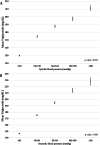Prevalence of hypertriglyceridemia among Royal Thai Army personnel and its related cardiometabolic risk factors, from 2017 to 2021
- PMID: 35978422
- PMCID: PMC9387031
- DOI: 10.1186/s12889-022-13992-2
Prevalence of hypertriglyceridemia among Royal Thai Army personnel and its related cardiometabolic risk factors, from 2017 to 2021
Abstract
Background: Hypertriglyceridemia is a common health problem independently associated with an increased risk of atherosclerosis cardiovascular diseases (ASCVD), including ischemic heart disease and stroke. This study aims to determine the prevalence of hypertriglyceridemia among Royal Thai Army (RTA) personnel and its behavioral and cardiometabolic risk factors using the RTA personnel database of the physical health examination from 2017 to 2021.
Methods: A serial cross-sectional study was conducted from 2017 to 2021. A total of 257,683 active-duty RTA personnel aged 35-60 years were included in the study. We defined hypertriglyceridemia as fasting triglyceride ≥150 mg/dL. Moreover, we performed a multivariable logistic regression analysis to investigate behavioral and cardiometabolic risk factors for the prevalence of hypertriglyceridemia. The magnitude of the association was presented as an adjusted odds ratio (AOR) with a 95% confidence interval (CI).
Results: The hypertriglyceridemia prevalence among RTA personnel was 43.4% (95% CI: 42.9-43.8%) in 2017. It then continuously decreased to 40.3% (95% CI: 39.9-40.7%) in 2020 and slightly rose to 41.0% (95% CI: 40.6-41.4%) in 2021 (p for trend < 0.001). The prevalence of hypertriglyceridemia was higher for males than females (AOR 2.15; 95% CI: 2.07-2.23); RTA personnel aged 40-44 years compared with those aged 35-39 years (AOR 1.05; 95% CI: 1.02-1.08); and RTA personnel residing in the northeast (AOR; 1.15 95% CI: 1.11-1.18) and the north (AOR 1.05; 95% CI: 1.02-1.08) compared with those residing in Bangkok. The independent behavioral factors associated with hypertriglyceridemia included alcohol consumption, smoking, and sedentary behavior. Moreover, cardiometabolic risk factors, including higher body mass index, high fasting plasma glucose (≥ 100 mg/dL), high blood pressure (≥ 140/90 mmHg), and hypercholesterolemia (≥ 200 mg/dL), were significantly related to hypertriglyceridemia.
Conclusion: Our data demonstrated that hypertriglyceridemia is a frequent health issue, especially among males, participants aged 40-44 years, and RTA personnel residing in the northeast and the north. The prevalence of hypertriglyceridemia in this population was greatly influenced by alcohol consumption, cigarette smoking, and sedentary behavior. Both behavioral and cardiometabolic risk factors are potential targets for intervention to enhance the primary prevention of sequelae of hypertriglyceridemia, including ASCVD.
Keywords: Behavioral risk; Cardiometabolic risk; Hypertriglyceridemia; RTA; Thailand.
© 2022. The Author(s).
Conflict of interest statement
The authors declare they have no competing interests.
Figures





Similar articles
-
Trends in Serum Total Cholesterol and High Total Cholesterol Prevalence Among Royal Thai Army Personnel in Thailand, 2017-2022.High Blood Press Cardiovasc Prev. 2023 Sep;30(5):445-456. doi: 10.1007/s40292-023-00596-z. Epub 2023 Aug 22. High Blood Press Cardiovasc Prev. 2023. PMID: 37606810
-
Rising trends in obesity prevalence among Royal Thai Army personnel from 2017 to 2021.Sci Rep. 2022 May 11;12(1):7726. doi: 10.1038/s41598-022-11913-2. Sci Rep. 2022. PMID: 35546180 Free PMC article.
-
Relationship between pulse pressure and body mass index in active-duty Royal Thai Army personnel in Thailand.BMC Cardiovasc Disord. 2023 Jul 18;23(1):361. doi: 10.1186/s12872-023-03390-w. BMC Cardiovasc Disord. 2023. PMID: 37464282 Free PMC article.
-
The Importance of Military Conscripts for Surveillance of Human Immunodeficiency Virus Infection and Risk Behavior in Thailand.Curr HIV Res. 2017;15(3):161-169. doi: 10.2174/1570162X15666170517122011. Curr HIV Res. 2017. PMID: 28521721 Review.
-
Hypertriglyceridemia and Other Plasma Lipid Profile Abnormalities among People Living with Diabetes Mellitus in Ethiopia: A Systematic Review and Meta-Analysis.Biomed Res Int. 2021 May 10;2021:7389076. doi: 10.1155/2021/7389076. eCollection 2021. Biomed Res Int. 2021. PMID: 34056001 Free PMC article.
Cited by
-
Rising trends in the predicted 10-year risk of cardiovascular diseases among Royal Thai Army personnel from 2017 to 2021.Sci Rep. 2023 Jan 26;13(1):1476. doi: 10.1038/s41598-023-28494-3. Sci Rep. 2023. PMID: 36702870 Free PMC article.
-
Relationship between triglyceride-glucose index and aminotransferase among Royal Thai Army personnel 2017-2021: a serial cross-sectional study.Lipids Health Dis. 2023 Apr 3;22(1):47. doi: 10.1186/s12944-023-01811-5. Lipids Health Dis. 2023. PMID: 37013603 Free PMC article.
-
Argan Fruit Polyphenols Regulate Lipid Homeostasis, Prevent Liver Fat Accumulation, and Improve Antioxidant Defense in High-Calorie Diet Fed Mice: In Vivo Study and In Silico Prediction of Possible Underlying Mechanisms.Metabolites. 2025 Mar 28;15(4):234. doi: 10.3390/metabo15040234. Metabolites. 2025. PMID: 40278363 Free PMC article.
-
Associations of triglyceride-glucose index with hyperuricemia among Royal Thai Army personnel.BMC Endocr Disord. 2024 Feb 1;24(1):17. doi: 10.1186/s12902-024-01542-3. BMC Endocr Disord. 2024. PMID: 38297286 Free PMC article.
-
Association between raised blood pressure and elevated serum liver enzymes among active-duty Royal Thai Army personnel in Thailand.BMC Cardiovasc Disord. 2023 Mar 21;23(1):143. doi: 10.1186/s12872-023-03181-3. BMC Cardiovasc Disord. 2023. PMID: 36944947 Free PMC article.
References
-
- Organization WH . Noncommunicable diseases country profiles. 2018. p. 2018.
-
- Sarwar N, Danesh J, Eiriksdottir G, Sigurdsson G, Wareham N, Bingham S, et al. Triglycerides and the risk of coronary heart disease: 10 158 incident cases among 262 525 participants in 29 Western prospective studies. Circulation. 2007;115:450–8. - PubMed
-
- Klempfner R, Erez A, Sagit B-Z, Goldenberg I, Fisman E, Kopel E, et al. Elevated triglyceride level is independently associated with increased all-cause mortality in patients with established coronary heart disease. Circulation. 2016;9:100–8. - PubMed
Publication types
MeSH terms
LinkOut - more resources
Full Text Sources
Medical

